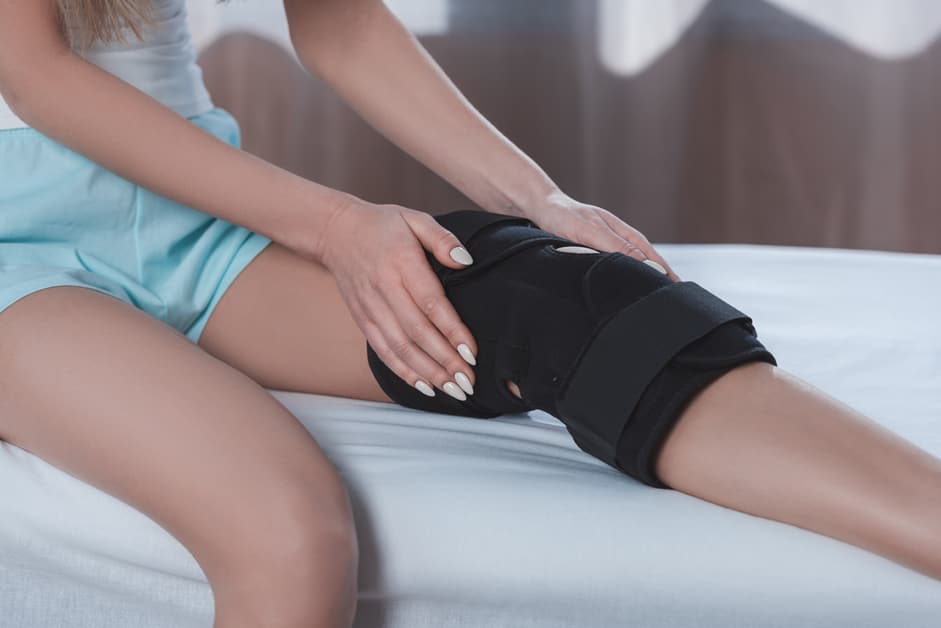Overview of Knee Pain
Knee pain is a frequent source of musculoskeletal agony. It can stem from a variety of causes. Symptoms may be slight aching or intensely disabling. Many people suffer from some degree of knee pain.
Wearing a knee brace is often suggested to provide relief and stop further injury. In this article, we look at the various causes of knee pain and the potential advantages of wearing a knee brace:
Types of Knee Pain
Knee pain can result from many conditions that involve bones, cartilage, ligaments, tendons, and muscles. A knee brace may provide relief, depending on your type of pain.
Types of knee pain include:
- Arthritis: Inflammation in the joint and surrounding tissues causes joint stiffness, swelling, and tenderness.
- Meniscal Tears: Overuse or a sudden twist may tear the meniscus, a cartilage pad cushioning the knee joint, causing sharp pain during certain movements.
- ACL (Anterior Cruciate Ligament) Injury: Damage to this ligament, which runs through the center of the knee, can cause instability or discomfort when leg movements are restricted.
- IT Band Syndrome: Exercising incorrectly or excessively can irritate the band that supports joint movement, leading to lateral knee pain.
- Patellofemoral Pain Syndrome (PFPS): Unbalanced thigh muscles can damage the cartilage around the kneecap, causing swelling, stiffness, and tenderness as well as painful moments while running or climbing stairs.
- Osgood Schlatters Disease (OSD): Common in active children, this condition is caused by overuse, with tendon fibers rubbing against nearby stores and causing pain across the front of the kneecap or just below it.
Causes of Knee Pain
Knee pain can have many causes, from everyday wear and tear to health conditions. Examples of these include:
- Injury or trauma, such as bruises, sprains, strains, or mechanical damage like dislocation or fractures.
- Overuse from activities like running, kneeling, jumping, or climbing stairs.
- Bone degeneration due to aging.
- Weak thigh muscles or tendons that don’t support the joint well.
- Misalignment of the kneecap due to injury.
- Overuse and muscle imbalances in people who are active in sports or exercise. This can cause tightness in certain areas and weakness in others, putting extra stress on the joint and leading to chronic instability and pain.
Benefits of Wearing a Knee Brace
Knee braces can be helpful for those with chronic knee pain. They provide support and reduce pain, inflammation, and instability. Moreover, they can improve mobility. This article will look into the advantages of wearing a knee brace and how it can ease the discomfort.
Supports Joints and Muscles
A knee brace can offer support to the muscles and joints of your knee. It keeps them in place, reducing strain and increasing movement. This boosts performance, with a reduced risk of injury. The brace also provides additional stability and might help mild discomfort.
Knee braces are made from materials such as foam and neoprene to offer control over the level of support for the knee. Straps can be adjusted for the correct pressure without causing any unease or hindering movement.
Knee braces also provide compression around the area. This reduces inflammation and puffiness, while providing full body weight support for activities like running, hiking, sports, and weightlifting. Additional advantages include:
- Increased proprioception for better balance and coordination
- Improved muscle stabilization for added joint safety during exercise
Prevents Further Injury
Knee braces can be used to protect and support the knee during physical activities. They offer stability, which reduces the risk of harm to the knee. A quality knee brace will keep the knee in check while you do activities like walking, running, and jumping. It can also reduce the pain from stress on the joint or ligaments.
Knee braces come in different types. You can get soft neoprene braces or rigid plastic braces. It depends on what your needs are and what type of activity you will be doing. Your doctor may also suggest a specific orthopedic device.
Reduces Swelling
A knee brace can reduce swelling and inflammation associated with chronic knee pain. Compression helps to reduce this inflammation and therefore reduces pain.
Knee braces also provide extra stability for weakened or injured ligaments and tendons. This limits the range of motion, minimizing strain on other parts of the leg, and offering pain relief.
Finally, wearing a knee brace during activities such as running and walking offers extra support for weakened joints and muscles. With regular stretching, the brace can speed up recovery and help you keep enjoying your favorite activities without re-injuring yourself!
Types of Knee Braces
Knee braces are essential for managing pain and injury. They give support to the knee joint which can help reduce aches from conditions like arthritis and tendinitis. Knowing the different types of knee braces is important to make the best decision for your circumstance.
Let us explore the various types of braces for knee pain relief:
Hinged Knee Braces
Hinged knee braces offer a rigid structure to give stability and support for the knee joint in case of sprains or ligament tears. They are used for moderate to severe sprains, torn ACLs and PCLs, and post-surgery rehabilitation. Hinges on these braces can be detachable or non-movable. Links and polycentric steel hinges provide stability and movement. Some hinged braces may have open backs for compression.
Types of hinged braces vary and give more or less movement. Soft forms are built with anti-bacterial or thin fabrics that compress slightly. Selecting the proper size is important to get the desired level of motion and participation. Healthcare providers will recommend the best option for lifestyle and needs.
Patella Stabilizing Knee Braces
Patella stabilizing knee braces are meant to decrease pain and improve tracking. They help with patellar instability, where the kneecap doesn’t stay in its groove. Two types exist: PFSS and PRO.
- PFSS have straps above and below the kneecap, adjustable for support. These straps sit up against the kneecap to provide compression.
- PRO braces have more of a frame. It wraps around the sides of your leg joint. This provides more stability and realigns shifted kneecaps. PRO braces have lateral support and still allow full motion.
These knee braces are to enable safe and comfortable movement. They reduce strain on the patellofemoral joint. Use them with other treatments like physical therapy and exercises for best results. With correct use, they can reduce knee pain from patellofemoral syndrome.
Neoprene Knee Braces
Neoprene knee braces are the go-to for joint support. Made from synthetic rubber, they provide pain relief, stability, and compression. They’re commonly used to treat patellar tendonitis, and for related pain in the lower leg and around the kneecap.
They come in wraparound, banded (with buckles), and adjustable styles. Wraparound and banded styles support the sides of the patella, and adjustable models can be adjusted for more comfort.
Neoprene supports have been a reliable source of symptom management for many years. Always consult a physician before wearing one.
How to Choose the Right Knee Brace
Knee pain? Ouch! A knee brace is a great way to get relief. But, how do you choose the right one? Here’s how…
- Pick a brace that fits your needs for maximum benefit. That’s the key!
Consider Your Activity Level
Picking the right knee brace comes down to your activity level and the support or protection you require. Braces can be found with different levels of protection, starting with basic straps and simple support, as well as more robust braces for higher-impact sports or activities.
If you’re doing low-intensity activities like walking, jogging, or sports like tennis or golf, a basic knee strap is probably enough. But if you’re doing intense activities like running, skiing, jumping, or contact sports such as soccer or football, you’ll likely need a more robust brace for added stability.
Before purchasing, make sure to think about the activity you’re doing, and decide what level of support you need. If you have any questions about your knee injury or the protection a brace can offer, it’s wise to consult your doctor.
Consider Your Lifestyle
When buying a knee brace, consider your lifestyle. Braces offer support, stability and comfort. Depending on how active you are, there’s a perfect one. Active people may prefer neoprene-based designs for protection and flexibility. Sedentary people may prefer open-patella designs for breaks and reduced pressure. Athletes recovering from injury need adjustable straps for immobilization.
When selecting, assess the brace’s supportiveness, durability, comfortability and adjustability. This will help you pick the best one for your needs.
Consider Your Comfort Level
Choosing the right knee brace for pain relief is key. Factors to consider include your physical activity level and location of the pain. Knee braces come in different styles, sizes and materials. Some are designed for specific areas while others are more general. It’s important to pick a brace that’ll provide enough support and comfort while avoiding more harm.
Think about how the material and fit feel. Is it too loose or tight? Does it move after activity or stay in place? Is the padding or straps causing discomfort? Use feedback from your physical therapist or doc if they referred you.
Check for
- adjustable straps,
- range of motion control,
- reinforced stays,
- shock absorption,
- copper/platinum ions, and
- odour control.
This can make the brace more comfortable to wear.
Conclusion
Knee braces can be effective for fighting knee pain. They can provide compression and support to weak or injured knees. Doing so stabilizes the kneecap and takes away stress from the damaged area. This can lower inflammation and relieve pain. Wearing a knee brace lets you do regular activities with less pain.
Also, it may let you increase activity levels for rehabilitation.
Knee braces are not the answer for all types of knee pain. But, they are worth considering before more serious treatments like surgery or injections. Talk to your doctor about the potential benefits of wearing a custom-fitted or adjustable brace for mild to moderate cases of knee pain.
Frequently Asked Questions
Q1: What are the benefits of wearing a knee brace?
A1: Wearing a knee brace can help provide support and stability to a knee joint as it helps to reduce pain and inflammation, improve knee alignment, and speed up the healing process of an injury.
Q2: How does a knee brace help reduce pain?
A2: A knee brace provides compressive support to the knee joint which helps to reduce inflammation and pain. The brace can also help to reduce the movement of the knee joint and keep it in a more comfortable position.
Q3: How long should a person wear a knee brace?
A3: It depends on the severity of the injury. Generally, a person should wear a knee brace for at least a few days to a few weeks, however, a doctor may suggest wearing it for longer if the injury is more serious.





